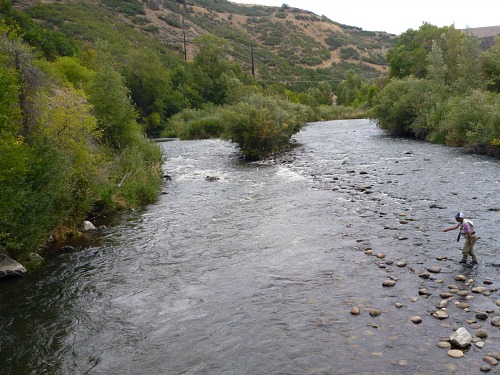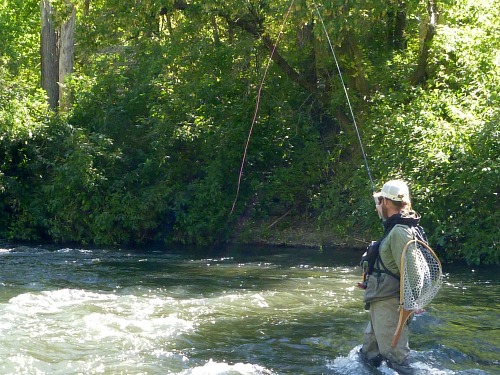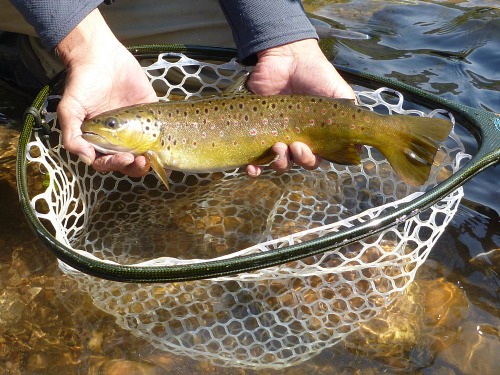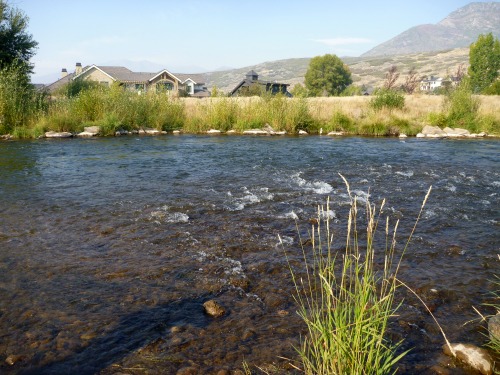Oni School - 2018
The Oni School is organized and presented by the Tenkara Guides LLC,
based in Salt Lake City, UT. The three guides, Erik Ostrander, John
Vetterli and Rob Worthing, have been working together for 8 years now,
and were the first tenkara guides outside Japan. They have been
presenting the Oni School for four years, and have recently formed Team
Oni USA LLC to be the US outlet for the Oni rods - Type I, Type II, Type
III, and the newly introduced Itoshiro. (The Nissin Zerosum Oni Honryu
rods are sold here on TenkaraBum.com.) Beyond selling rods, though, Team
Oni USA’s mission is to introduce “Oni Tenkara” to US anglers.
The Oni School 2018 is now over, and planning for next year’s school
(the fifth anniversary) has already begun. This essay is a brief review
of my impressions of this year’s school, and a superficial description
of Oni Tenkara, which is what the Tenkara Guides call the style of
tenkara that Masami Sakakibara (Tenkara no Oni, or just Oni) has
developed over the the 40-odd years that he has been doing tenkara.
The Oni School is a three-day event, held this year on the Middle and
Lower Provo River, just south and east of Salt Lake City. It started
with an early morning meeting and brief orientation at the Sundance
Resort, followed by a casting clinic, during which each student got
one-on-one instruction from Oni. Erik, John and Rob also helped any
student who had further questions (at the casting clinic and any time
during the entire three day school). Following the casting clinic, Oni
gave a demonstration of still water tenkara in a pond on the Sundance
grounds.
The demonstration showed casting, a simple pulsing
manipulation, the sutebari technique (repeatedly casting to one spot and
picking up for a new cast immediately after just the fly has touched
the surface - which obviously did excite the stocked rainbows in the
pond) and fish fighting technique. In prior Oni Schools, Oni fished the
pond with a fly from which the hook had been cut at the bend, so
fighting the fish lasted only the few seconds until the fish spit out
the fly. This year, with regular hooks, Oni landed several fish.
Although the fish were not large, his fish fighting style was consistent
with how he fights a much larger fish.
Following the demonstration at the pond, the class relocated to the section of the Provo that the Tenkara Guides had chosen specifically to illustrate how Oni approaches a section of any stream. How he does it is too complex to fully describe here, and I’m sure I don’t yet fully grasp the nuances, but the basis of his approach is to be able to fish all the likely spots, with both upstream and downstream presentations, without spooking any fish.
 Tenkara no Oni's approach.
Tenkara no Oni's approach.The photo above is from a prior year, but it illustrates Oni fishing the
seam between the faster current and the slower water on the near side
of the run. After he fished the near side of the entire run, he then
came back down to the bottom of the run and fished the quiet water
along the far bank. That allowed him to fish the entire run, bottom to top and side to side without spooking any fish by getting too close. This year he caught several fish during his presentation.
I have written previously about my impressions of having fished with
Tenkara no Oni, both in Japan and in the US. The first time, in Japan,
and with no one there to interpret, the one thing I took away from that
session was the importance of getting in the right position before
making your first cast. In order to fish different spots, you almost had
to be in different positions.
Sounds obvious, but it most
definitely was not wading upstream, casting upstream as you go.
Sometimes he cast upstream, sometimes across and sometimes downstream
from where he was standing. More than once, he stopped me from casting,
got me to move to a different position, and then signaled I should make
my cast. In at least one case, he stopped me from making an up and
across presentation, moved me upstream, and had me fish that spot with a
downstream presentation. That downstream presentation yielded a fish.
I now believe that if he had thought
my skill level had been up to it, he would have had me fish that spot with
both upstream and downstream presentations.
I have also written
several times how I was surprised at the amount of time he spends fishing downstream from where
he is standing. I had always believed that upstream presentations were
superior (despite knowing that people do catch fish swinging wet flies,
or doing a Leisenring Lift, both of which are downstream presentations).
What didn’t really click until this Oni School (and this one was my
third), was that the upstream and downstream presentations look
different to the fish, and some fish that ignore an upstream
presentation will hit a downstream presentation. With Rob Worthing’s
descriptions of how Oni makes the upstream and downstream presentations,
I proved that one to myself, fishing the same section of slow water
along the riverbank four times, first with an upstream presentation near
the surface, then an upstream presentation deeper in the water column,
then after moving to stand in a different spot, with a downstream presentation near the surface, and finally a
downstream presentation deeper in the water. I caught a fish on that
last presentation. My fly had drifted past that fish three times
already, but at different depths and speeds.
A critical element
in getting into the ideal position for each presentation, whether
upstream or downstream, is not spooking the fish before you have a
chance to make your first cast. To do that effectively, you have to plan
out what lies you want to target, and where you will want to stand for
each upstream and downstream presentation.
To get into all the
positions from where you will want to cast, and not spook fish to which
you have not yet presented your fly (both upstream and downstream), you
really do have to carefully plan it out in advance. You almost certainly will not hit all lies sequentially! If you just wade
upstream, casting as you go, you are probably spooking most of the fish
to which you have not yet made a downstream presentation. To be frank,
if you are like most fly anglers, you wouldn’t have even thought of
making downstream presentations. I know I wouldn’t have.
 Erik Ostrander demonstrating upstream shallow presentation.
Erik Ostrander demonstrating upstream shallow presentation.After Oni’s demonstrations on day 1, and for most of the day 2, we
practiced what we had seen with respect to getting into the best
positions for each presentation for each attractive lie. Doing drills
making both upstream and downstream presentations. Day 2 was also
wonderful practice in fishing on a windy day.
I had gone to the
Oni School with a serious misconception. I had thought that Oni only
fished very light line - size 2.5 or even lighter. On day 2 he fished a
size 4.5 line. With the strong wind, and the large fly he fished for at
least part of the day, a heavy line was the best choice.
 Oni's trout by the bridge.
Oni's trout by the bridge.There was a bridge near where we parked on the second day. We could see a couple nice fish from the bridge and Oni decided to fish for them. No matter how he presented his fly, they weren't interested. (We later learned that both had been caught by a couple anglers who by then were just downstream of us.) Oni then started casting across the river to a big eddy caused by the bridge abutment. Keeping his line entirely off the water, over the current, he held the fly in the eddy and pulsed it very gently. On his third or fourth cast, the nice fish shown above nailed his fly.
Day three for me was a revelation. I have long known that quiet water
just below a short shallow riffle almost always holds fish. I have
always fished that feature from the side, which almost always involves
trying to hold the line over the slower water on the side and fish the
faster water just as it starts to slow following the riffle. Getting a
good drift while minimizing drag is a constant battle. There was one
truly excellent example of that riffle-pool feature where we started the
second day.
Oni stood well upstream of the pool and fished a
straight downstream presentation, holding the fly stationary and making
subtle pulses. He caught at least four fish and probably missed that
many more. He never had to worry about current differentials or drag
pulling his fly out of position. I never even would have thought of
fishing straight downstream in that situation, keeping the fly on the
surface when the rod tip was high, and under the surface when the rod
tip was low.
 The pool below the riffle.
The pool below the riffle.It wasn't until his demonstration was over that I realized I had been watching so intently that I had forgotten to take a photo of his demonstration. The photo above is the riffle and pool. It was truly surprising that fish came up through pretty fast water to hit his flies as he pulsed them on the surface.
Later in the day, I saw a similar feature and tried
to mimic Oni’s technique. I got three hits although I managed to miss
them all.
Also on the third day, And with Erik’s instruction, I
finally had success casting and controlling my line when fishing in a
strong wind. I didn’t hook any fish, but just being able to cast where I
wanted to and keep the line under control was a new experience. Size
4.5 line to cut the wind and a large bushy fly to anchor it helped
tremendously. I had thought that wind was the kiss of death for tenkara fishing. I was wrong. The wind, like the current and the depth, is just one more variable affecting your line, fly and drift - which is what keeps tenkara complex rather than simple.
The fishing in the wind and the success fishing a
downstream presentation to a fish that had ignored an upstream
presentation illustrates one of the tremendous benefits of the Oni
School - and why it is actually more beneficial than flying to Japan -
even for a guided trip by Oni himself. First, Oni’s English is limited,
so if you are not fluent in Japanese your experience fishing with Oni in
Japan will likely be similar to mine - you might come away with one major
lesson, but little detail and no nuance. The Tenkara Guides have fished
with Oni many times, both here and in Japan, and have been able to learn
much more than anyone could possibly learn in just one session. Also,
they are extremely skilled tenkara anglers in their own right.
Much of
what I learned at the Oni School 2018 was from Rob or Erik explaining
what Oni was doing, along with why and how he was doing it. And that is not to say that John is not their equal as a teacher and guide. When he and I get together, though, we mostly just hang out and fish - kind of like when the Guides first fished with Oni in Japan. They weren't looking for lessons - they just wanted to fish with him. Of course, just fishing with him - or with John, you will end the session knowing more than when you started.
TenkaraBum Home > Trip Reports > Oni school 2018
“The bitterness of poor quality remains long after the sweetness of low price is forgotten” - Benjamin Franklin
"Be sure in casting, that your fly fall first into the water, for if the line fall first, it scares or frightens the fish..." -
Col. Robert Venables 1662
As age slows my pace, I will become more like the heron.
We've all had situations where seriously chewed up flies kept catching fish after fish after fish. It is no sin to tie flies that come off the vise looking seriously chewed up.
Warning:
The hooks are sharp.
The coffee's hot.
The fish are slippery when wet.
Beware of the Dogma
What's in stock?
Suntech Tenkarakyo 40F Tenkara Rods
Coming Soon
December
Kurenai II AR 30F
Kurenai II AR 33F
Kurenai II AR 39F
Nissin Oni Line size 3
Nissin Oni Line size 3.5
TenkaraBum 33
TenkaraBum 36
TenkaraBum 40
Medium Rod Case
January
Furaibo TF39
Furaibo TF39TA
Latest Pages
If you enjoy spin fishing or baitcasting please visit my sister site Finesse-Fishing.com.


